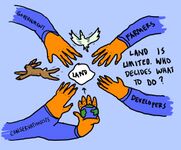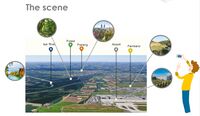LED2LEAP 2020 - Freising Team 1
Jump to navigation
Jump to search
>>>back to working groups overview
Landscape Democracy Rationale
- The community context is relevant because the landscape is function of how the community sees the landscape. As we understand how the community interprets the landscape we can build a better landscape that works for them. As our community grows we want to ensure the health and wellness of both the humans and the natural landscape.
- How does the landscape work for the benefit of human health and wellness? How can we bring community together to provide a healthy and happy life? That is the hypothesis considering the landscape democracy challenges.
Location and scope
- The overall location is the space between the two points, the Munich Airport and Dachau.
- Our main focus area is the Airport region south of Freising. Notice the large yellow areas around the airport, that is farmland and pasture. Also notice the water bodies surrounding the airport, they play an important part to the health of the area.
Phase A: Mapping your Community
Welcome to your community and its landscape
- The west side of the Munich Airport.
- Industural, agricultural, and nature land types.
- Freising is a young comunity.
- Issues with urban spraul, and maintaining a productive agricultural economy while allowing a positive life for humans and nature.
Groups of actors and stakeholders in your community
- Key Actors (Local Residents, Municipalities, Government, Landowners)
- Primary Actors (University, Schools, Students, Elderly, Families, Farmers, Airport Administration, Airport Employees, Unions, Munich commuters) These actors are concerned with their own health and those around them
- Secondary Actors (Small businesses, Tourists, Community Centers, Beer production, Religious Centers)
- The most visible actors are the landowners, the University and the Airport. All others are less visible.
- What we don't know is the direct thoughts of the citizens, we are working off assumptions based on reading and research.
Relationships between your actors and groups
- The power relationship is complicated but overall the large groups have more power than the smaller actors.
- Food production brings together the landowners, farmers, business owners and government regulators.
- Many groups have a shared interest in the Airport and its functions. The workers, administrators, tourists, and people in the transportation sector have a lot of stake in the airport.
Summary of your learnings from the transnational discussion panel on April 22
- From the meeting on April 22, we learned about different ways to view the landscape. From on of the talks we leaned more about the power structures and socioeconomic differences that lead to the benefit of one group but not of the other. We learned of a better way to present information and how to show what we did and not to tell what we did.
Theory reflection
- From the article The Just City Essays - 26 Visions for Urban Equity, Inclusion and Opportunity I got a better perspective on what is important for community inclusion. Being a good member of a community means having the goal of justice at the forefront of design. I want to think about how the design will positively or negatively influence the different members of the community and make changes from that.
- The article Pledge for a Transformative Science - A conceptual framework showed me the future thought process in how we use the scientific method. It reminded me a lot of the iterative process of having a problem, working to find a solution and then building off what you learned to continuously improve that was talked about in the lecture. I also like the holistic approach the article took about science.
- In The Right to Landscape: An Introduction, in: The Right to Landscape: Contesting Landscape and Human Rights, we learned how the right to landscape is a human rights issue. Landscape can provide many things, health and physical well being, mental well being, and economic well being. We need to focus on how we can up lift communities without landscape and create an environment that everyone can thrive in.
References
- The Just City Essays - 26 Visions for Urban Equity, Inclusion and Opportunity [1]
- Alejandro Aravena: My architectural philosophy? Bring the community into the process [2]
- Higher Education System in Germany [3]
- EVG [4]
- GEW [5]
- IGBAU [6]
- Pledge for a Transformative Science - A conceptual framework [7]
Phase B: Democratic Landscape Analysis and Assessment
The Scene in your Story of Analysis
- The landscape democracy challenge we face in our area is the expansion of the Airport to build a third runway. The expansion will harm the protected bird areas and reduce farm land, however, the expansion will also provide jobs for people and be a benefit for the economy. The scene we tell our story in is around the Airport area, incorporating the Isar River, the farmland and the city. The area has a low unemployment rate and has many young families and airport workers. Politics are based around the Airport Administration and local government.
The Actors in your Story of Analysis
- The characters in the story are the farmers, airport workers, airport administrators, construction workers, families, teachers and students. The main character is a student that is motivated by minor characters (farmers, families and teachers) to organize a protest against the expansion of the airport. This protest is countered by other minor characters (airport workers, construction workers and airport administrators). The relationship between the construction workers and the airport is very strong. If the construction takes place the workers are needed. The farmers need their land and will be greatly affected by the expansion.
The Story of Analysis
- The story begins with a student on a plane arriving to Freising without a place to stay. On the plane they meet a nice elementary school teacher who offers a bed for the night. The student learns from a farmer and the family the issues with the expansion of the airport. Sitting by the Isar river the student is motivated to organize a protest about the expansion of the airport. During the protest a counter protest starts from the construction workers and airport workers. This opens up the students mind and creates a wicked problem in their mind. The student sees a need for community engagement and works with the Environmental Autobiography Adaptation method and the community members. Through this method the all community members learn about the other.
Reflect on your Story of Analysis
- The tool we chose to utilize in the community fit our community best because it allowed the members to be active and engaged while allowing for the other members to get a valuable and intimate look into their lives. What we carried was different points of view, community relations and the relationship between different histories. Why did we carry? We carried because we needed to understand the community better and have the community understand itself better. How did we carry? We carried using empathy, flexibility and humility for our fellow community members. What we want to leave behind is a better understanding of the community and the connections they all share. Overall, the actors we gathered, are from different parts of society, and each lead very different lives. Therefore, the sketches that they will produce will most certainly view the issue from different vantage points. This is essential to understand the community, and this method provides this flexibility in a very calming setting. It is also a good exercise to self reflect on one's own values and expectations from this community.
Phase C: Collaborative Visioning and Goal Setting
The Scene in your Story of Visioning
- Reiterate your landscape democracy challenge, by making a problem statement based on your landscape evaluation and the results of your Phase B assessment. Describe your challenge by digging further into the the physical scene and the community associated with this place.
- add the corresponding visual from your presentation to the image gallery below
- Yourcase scene1.jpg
add a caption
The Actors in your Story of Visioning
- Describe the particular characters that are going to participate in the visioning phase. Why were they chosen to participate and where will the visioning phase happen?
- add the corresponding visual from your presentation to the image gallery below
The Story of Visioning
- Describe the crux of the story. How did the actors engage in collectively developing the goals, and what was the process involved in prioritizing them? Slide 1
- What is the visualization, the actual vision, that expresses the synthesis of these prioritized goals? Slide 2
- What is the strategy that was built for attaining one of these goals, the three year plan of action? Slide 3
- add the corresponding visual from your presentation to the image gallery below
Reflect on your Story of Visioning
- What points were most important when formulating goals and what are the common characteristics of a good vision?
- add the corresponding visual from your presentation to the image gallery below
- Yourcase refelction1.jpg
add a caption
Phase D: Collaborative Design, Transformation and Planning
* template coming
Phase E: Collaborative Design, Transformation and Planning
* template coming
= Phase E: Collaborative Evaluation and Future Agendas * template coming
Process Reflection
- Reflect in your intercultural and interdisciplinary team on the outcomes of your study
- Which limitations were you facing?
- What have you learnt from each other?
- What would you do differently next time?
- You can also use diagrams/visuals
- 250 words text
























